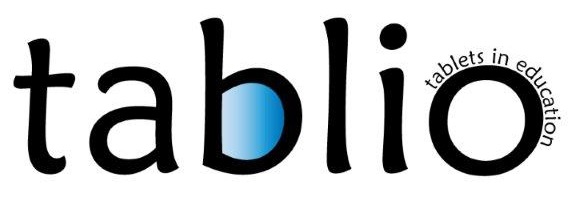Meaningful learning using technological devices

Description
The schools
Primary school De Driemaster is a small rural school with one group of students per grade. The school's mission is to offer meaningful education in a meaningful context. In doing so, students respond to the individual development opportunities, and there is a lot of attention for student autonomy.
Primary school Het Kleurrijk is also a relatively small school. It is a community school (combination with other facilities such as out-of-school care). The school works with TOM (Tailor-made Team Education). From this working method the school works with units (groups 1-2, groups 3-4, groups 5-6, groups 7-8), whereby teachers from different classes within a unit work together a lot. The school uses combination classes (two consecutive grades together). The mission of Het Kleurrijk results in a lot of attention for providing a personalised meaningful learning environment.
Both schools have been working with technological devices for some time (Chromebooks in the upper years, tablets in the lower years). These are mainly used as a class or for working individually with drill and practice software. The teachers also see opportunities to use the devices to contribute to more meaningful education.
The Teacher Design Team (TDT)
The design team included two teachers, one year 8 teacher (age 12) from De Driemaster and one year 3/4 (age 6-7) and year 5/6 (age 8-9) from Het Kleurrijk. The TDT also included a teacher trainer, a media coach, an ict expert, a Tablio project member and someone to facilitate the design process.
The design challengeBoth teachers are convinced of the chances of using mobile devices in their school. They think they could be used in different and more meaningful ways than currently done. The teachers see the availability of the technological devices as an opportunity to enrich education and deepen learning: the devices could contribute to more meaningful learning. The teachers want to include their teams in the more meaningful use of the devices. They also want their colleagues to learn how to design meaningful learning activities/learning designs and thus approach education differently: not just by following the method, but by occasionally replacing part of the method with a more meaningful instructional format.
At Het Kleurrijk, disappointing student test results have led to a focus on improving mathematics instruction. The teachers think that applied arithmetic (arithmetic in practice/context, e.g. in workshops) could help in this process. There is also a lack of intrinsic motivation and independence among the students. Their attitude when working on assigned tasks is poor. The teachers believe the students’ problems with motivation and work attitude are one cause of the poor arithmetic results. Students also have a poor work attitude/motivation in relation to other subjects.
The TDT formulated the following design challenge:
How can I (re)design meaningful learning activities/learning designs in which students use technological devices in a meaningful way?
The TDT wanted to achieve the following objectives with our design:
1. We want to use meaningful learning designs with ICT to ensure that students are more involved in the subject, that they understand more clearly why they are learning something and that the learning outcomes improve.
2. We want to encourage our colleagues at school to design and implement meaningful learning designs with ICT for their students.
A potential product would be a set of developed meaningful learning designs with ICT that include various ICT applications. These learning designs would serve as examples and inspiration for the school team to use technological devices in different, more meaningful ways.
Timeline of the process followed by the TDT
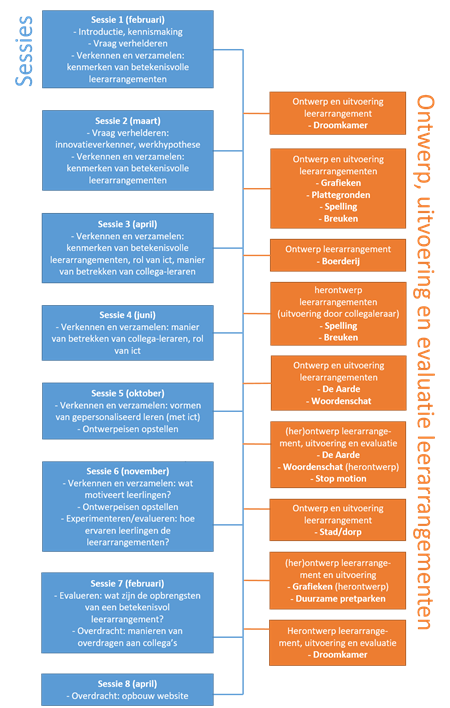
The timeline above shows how the TDT’s process unfolded. In total, eight sessions (blue) were held over one year. Between sessions, teachers were involved in designing, redesigning, implementing and evaluating learning designs (orange). The teachers were supported by worksheets/homework assignments.
The TDT arrived at three essential characteristics of meaningful learning designs:
• Context/authentic/imaginable/corresponding with experience/practice
• Active learning/creating/making something
• Self-direction, freedom to choose approach (differentiation in instructional format).
Features the TDT does not think of as essential but would be nice to have:
• Differentiation according to level (this is related to self-direction)
o Differentiation in difficulty of the activity
o Differentiation in degree of guidance
• Activating prior knowledge (helps to put the activity in context)
The characteristics of differentiation can be found in the concept map on differentiation from the Tablio project (see tablio.eu). This concerns differentiation at the micro-level. Self-direction and freedom to choose the approach are about differentiation focused on the students’ learning profiles and interests. Learning level differentiation can be found in the concept map as differentiation aimed at the starting level. According to the abovementioned characteristics, meaningful learning designs may involve content differentiation (e.g. whether students can autonomously choose fields of interest, learning questions or difficulty levels), process differentiation (when choosing the approach and differentiation in degree of guidance), and/or product differentiation (if students can choose how they develop the product).
Use of ICT
The SAMR model from Puentedura (2009) distinguishes four levels of ICT use in a learning activity. These range from Substitution (ICT as a replacement for an outmoded learning activity, e.g. book behind glass) to Redefinition (redefining your education so it is impossible without ICT) (see Figure).
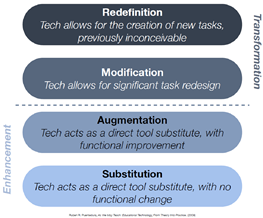
The TDT used this model to evaluate and improve the use of ICT in meaningful learning designs. In Session 3, the TDT compared several of the meaningful learning designs designed by the team. This comparison was based on these questions:
• What is the current level of ICT in this learning design?
• What can we change to reach a higher level of ICT use? And is this desirable in view of the objective of the learning design?
Based on the discussion of the learning designs using the SAMR model, the TDT concluded that the aim was for meaningful learning designs using ICT with added value. This does not necessarily mean that a higher level in the SAMR is better. The TDT wanted to create meaningful learning designs in which ICT makes an important contribution; not use ICT for the sake of using ICT.
The personalised learning scale
To evaluate the extent to which the learning designs to be designed contain elements of personalised learning, the TDT used the “personalised learning scale” (“Meetlat recht doen aan verschillen”) from iXperium/CoE can be used. This scale consists of several evaluation questions to assess the extent to which various aspects of personalised learning are used in a learning package and what the role of ICT is in this context.
Example of one of the developed learning designs
Title: Dream Room learning design (first design)
By Koen, year 8 teacher, De Driemaster
Description of the learning design
The goal of the learning design is was to do scale calculations.
Children start by thinking about their “dream rooms”, and first make a rough sketch on paper.
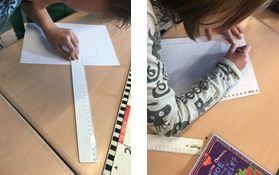
The rooms really comes to life when the children work out their sketches using an online site called Floorplanner.com. The interiors takes shape, the walls are coloured, and they see the extent to which their sketches are realistic: the walls and floor area are adjusted to the agreed dimensions (4 x 6 metres).
Children see their drawing in 2D, but they can also use the 3D function to enter their room.
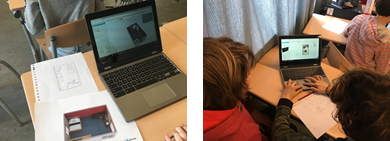
When a room is ready, the teacher prints it in 2D and 3D and the children use this printed image to determine the correct dimensions of everything in the room. This is essential because the next step is to make a physical model (crafts). We agreed on a scale (1:20) and the children start the preliminary work.
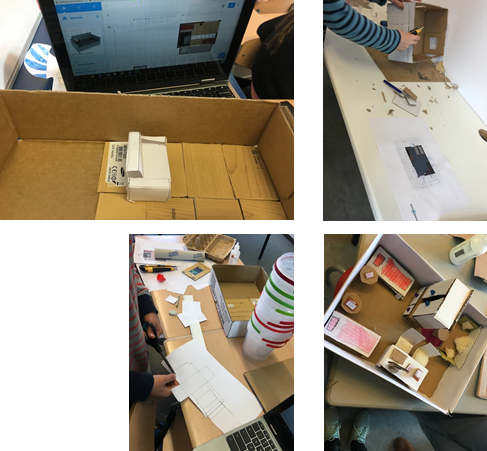
How does the teacher experience this learning design in the group?
The teacher experienced it as very positive and pleasant. Children were actively involved in all phases of the assignment. It was about scaling, and he made that clear to the children often by repeatedly asking if their initial sketch was correct or by having them think about how big something should be. The ICT part was used to bring their dream rooms to life. The children enjoyed designing the rooms, and it was up to me to check that the process was not just about having fun, but also to make sure they were really thinking about the surfaces: what would fit and what were the possibilities?
What did the students learn (according to the teacher)?
The teacher indicates that it is difficult to say whether this was a better way for the children to learn than just using regular books. What he saw was that the children were enormously engaged, and they really thought about all the learning questions. The children were not just doing sums but were deliberately working on the scale calculations. We also had a good class discussion about what the scale should be and what that means.
What were the students' reactions?
The children were very positive. They did not fully perceive that it was actually an arithmetic lesson, and they wished that arithmetic lessons would ‘always’ be like this.
Design-redesign
In the TDT, the teachers redesigned a number of the tried-and-tested learning designs. They did this based on their findings during the trials and based on the information collected during the exploring and collecting and establishing design requirements phases (see timeline). They used the established characteristics of meaningful learning designs, the SAMR model (see Section 2.2) and the personalised learning scale.
Evaluating
From evaluating the Dream Room learning design, the TDT concluded that – as expected – a meaningful learning design with technological devices increased student engagement. The students worked intensively and were inadvertently working on their numeracy. Afterwards, several students indicated that they learned more in the meaningful learning design than in a regular lesson, or that what they learned was easier to remember.
The components of the learning design seem to have contributed to these experiences. Due to the authentic context and the creation of their own dream room, students became more engaged and the usefulness of the calculations became clearer. Using ICT contributed to making the learning design even more meaningful or ‘more real’ (‘buying’ flooring and paint on a website, converting a 2D design into a 3D design in Floorplanner). The freedom of choice that students had in performing the assignment (creating their own design, making their own choices in spending the budget) also led to greater engagement and motivation. Finally, the learning design considered individual differences (personalised learning) in various ways: the learning design was offered at two levels of difficulty, students were guided in accordance with their individual instructional needs and students could review the instructions at their own pace. This enabled the students to work at their own level.
Design requirements for designing meaningful learning designs
The TDT wants to share their design requirements with teachers that want to design their own learning designs:
Learning objectives, alignment with curriculum/method
The learning activities are in line with learning objectives of the curriculum/method. The approach in practice may deviate from the method; this is even encouraged!
Characteristics of the learning design
The learning design is meaningful. This means that the learning activity contains at least these elements:
• context/authentic/imaginable/in line with experience/practice
• active learning/creating/making something
The learning design can be made even more meaningful by:
• Activating prior knowledge (helps to put the activity in context)
• The product of the learning activity is actually used (e.g. by others) or is presented to others
Form of differentiation
• Students have self-direction/freedom of choice with regard to their approach in the learning design
• If possible, there are also other forms of self-direction or differentiation, e.g. regarding interests, level, time and place of learning, pace
Grouping forms
Collaborating, learning from and with each other
Role of ICT
• ICT provides added value to the learning design (the use of ICT adds something; it is more than just a replacement for paper teaching material)
• The hardware and software are easy for the students to use/learn
Organisational aspects (duration, planning, preparation time)
The learning design can replace regular lessons about the corresponding subject/learning objective. Sometimes extra time is required, such as time normally reserved for crafts, ICT or projects, or it can be part of the weekly task.
The teacher’s role
The teacher mainly has a supervisory role, but instruction can also be part of the learning design
Assessment of learning outcomes
Learning outcomes of meaningful learning designs can be assessed by, for instance, asking students to explain what they have learned. Suitable forms include presentations, portfolios or demonstrations of products the students created. Regular tests can also be used, since the learning designs are in line with the learning objectives from the curriculum.
The design team is in the process of creating a website with lesson descriptions of the developed learning designs, so teachers from the participating schools and beyond can use them.
Acknowledgements
This chapter has been written based on a larger and much more extensive progress report by Marjoke Bakker, the researcher that was part of the TDT.
